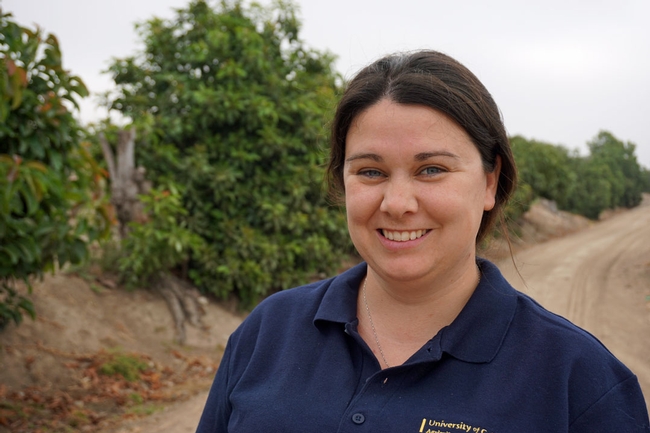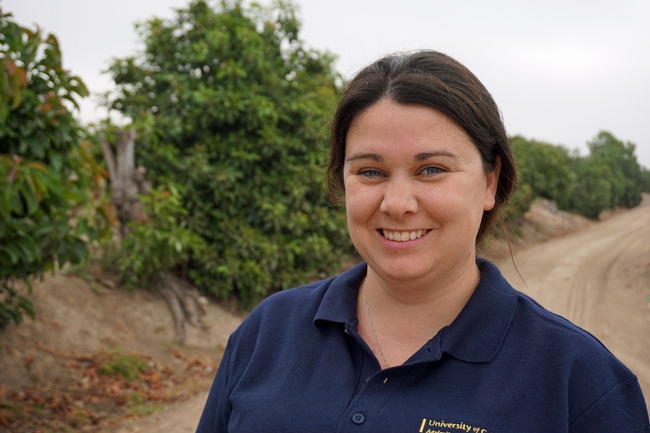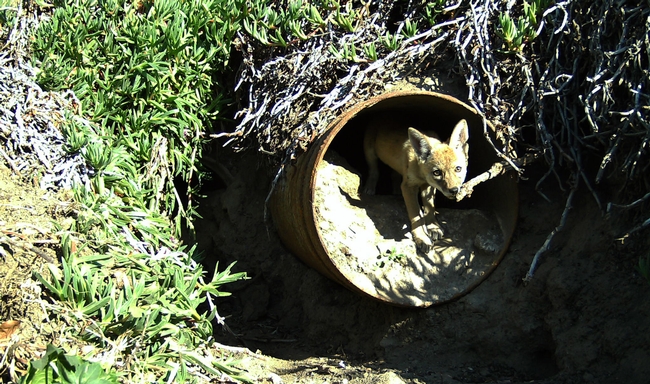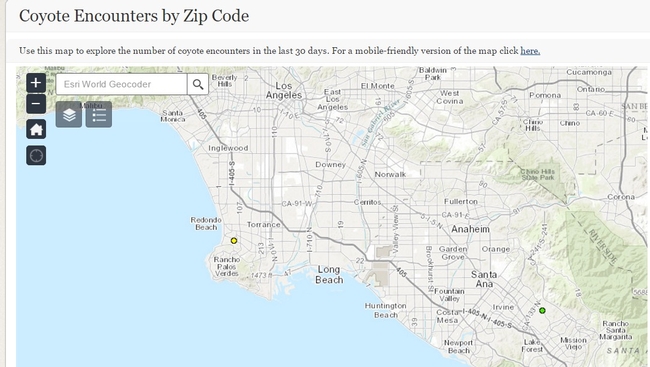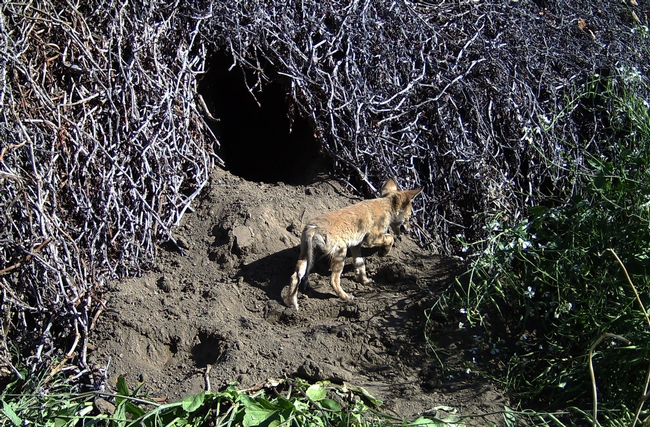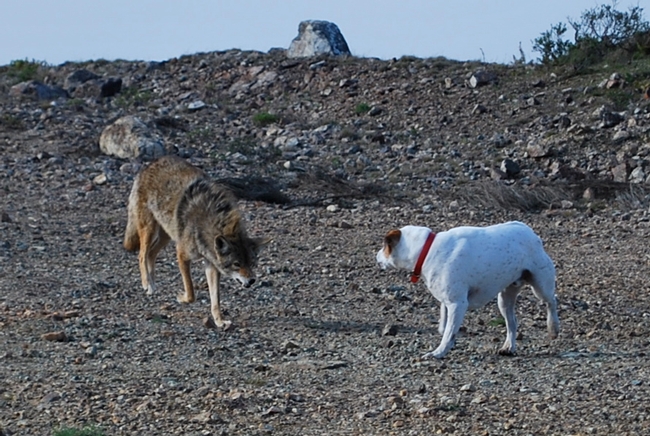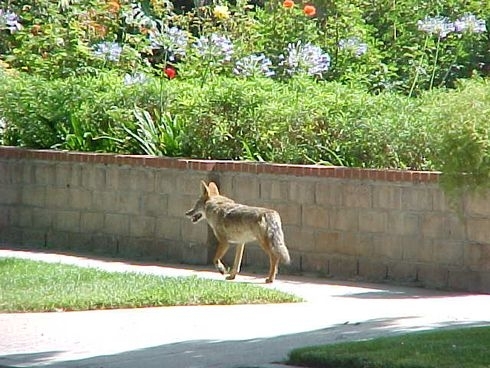Posts Tagged: coyotes
UCCE researcher studies urban coyotes
Some people believe shouting, waving arms and flashing lights will keep coyotes at bay, but UC Cooperative Extenison wildlife-human interaction advisor Niamh Quinn isn't so sure, reported Louis Sahagun in the Los Angeles Times. Like any scientist, she is now conducting a research project to understand whether such hazing deters the wild animals from making their homes in urban areas.
"There is no scientific evidence that hazing alters the behavior of urban coyotes," Quinn said."Yet, it is being pitched as a good option for coyote management."
Quinn is trapping coyotes, sedating them, attaching radio collars, tagging their ears and tracking their movements to understand whether the techniques recommended by some cities and animal rights groups are effective.
“We want to figure out when, where and for how long it actually works, or if it even works at all,” she said. “For the sake of our communities, and coyotes, too.”
UC scientist analyzes coyote stomach contents to study diet
Shoes with rubber soles, western cottontail rabbits, birds, avocados, oranges, peaches, candy wrappers and fast-food cartons were among the contents that UC Cooperative Extension human-wildlife interactions advisor Niamh Quinn has found inside the stomachs of urban coyotes, reported Louis Sahagun in the Los Angeles Times.
Quinn is working with Cal State Fullerton graduate student Danielle Martinez to get a clear picture of what is sustaining coyotes that died across Los Angeles and Orange counties.
"This much is clear: coyotes aren't struggling in our urban environments," Quinn said. "They are almost everywhere, continually learning to adapt alongside us."
Quinn also developed the Coyote Cacher web application to catalog reports of coyote sightings throughout California. Users can see when and where coyote interactions occurred.
"Was howling at an ambulance going down PCH toward Hoag Hospital in Newport Beach," a report posted this month said.
"Killed and ate my cat," said another from the same area.
The stomach contents study indicates that cats make up only about 8 percent of the urban coyotes' diets. Dogs aren't part of the study because it would be difficult to differentiate the DNA of coyotes from other members of the canid family.
New mobile app to track close encounters with coyotes
As urban coyote numbers rise, the animals are increasingly crossing paths with residents. There have been police reports of coyotes attacking pets and even people, but there has been no place to report casual coyote encounters. Now there is a new mobile app to help keep track of where those wily coyotes are coming into contact with people. Hikers and people walking their dogs can use Coyote Cacher, created by the University of California Agriculture and Natural Resources, to report coyote sightings.
“I'm so excited about this app because it will help us to collect better information on coyote conflict in California,” said Niamh Quinn, UC Cooperative Extension advisor, who studies human-wildlife interactions. “Coyote conflict appears to be particularly high in Southern California and it seems to be emerging in other areas. The information people provide through Coyote Cacher will help inform government agencies, wildlife researchers, park managers and residents to make better coyote management decisions.”
By reporting encounters with coyotes in their neighborhoods, residents can share information to help neighbors keep their pets and children safe.
“There is a coyote encounter map that will allow the public to keep track of what is happening in their areas,” said Quinn, who is based in Orange County.
Individuals can use the app to check a map to see locations of coyote sightings. Pet owners may decide not to let their pets out at night unsupervised in areas where coyotes have been reported.
“The app allows users to sign up for email alerts,” Quinn said. “These alerts – green, yellow and red – notify users when there is a coyote encounter reported in their zip code.”
Green is the lowest alert level and will give alerts for all coyote encounters in the user's zip code, from sightings to a person being bitten. Yellow will not alert users about sightings, but will let them know about all levels of pet interactions, including pets being chased or attacked off-leash by coyotes, and red alerts. Red is the highest alert level and allows for users to be informed only about the more serious incidents, for example, a coyote attacking a pet on a leash or biting a person.
“This app will also allow me to gather baseline information on coyote activity and the success of community hazing,” Quinn said.
Community hazing involves people shouting and waving their arms at coyotes and generally being obnoxious to make the nuisance animals afraid of humans.
“It would be great if everyone would do this when they see a coyote, but at the moment this is not really happening,” Quinn said. “Also, coyotes in Southern California appear to take a lot of risks and come in close contact with humans so community hazing may not deter them.”
More intense hazing, like shooting them with paintball guns, might be more effective techniques for government agencies to manage urban coyotes, she said.
To find out if any of these techniques work, the UC wildlife scientist would like to put collars on urban coyotes to study whether the animals move away from locations after hazing.
“We are seeking funding to collar coyotes to find out more about their activity and social structure and how they react to different types of management,” Quinn said. “We would need to figure out if the effects of the hazing are long-lasting, or if the coyotes just revert to ‘bad behavior' when the hazing is stopped.”
Although Quinn's research is focused on California, Coyote Cacher can be used anywhere in the United States. The website also offers information about urban coyotes.
Coyote Cacher can be used on a computer or on a mobile device at http://ucanr.edu/CoyoteCacher.
The Coyote Cacher app was designed by UC ANR's Informatics and Geographic Information Systems and funded by UC Cooperative Extension in Orange County.
Coyotes are getting comfortable in Southern California
In another sign of growing frustration with wildlife in Southern California residential areas, a coyote was shot and killed in a Silver Lake neighborhood by an unknown suspect in June, reported Nina Agrawal in the Los Angeles Times. Residents are taking to social media to commiserate about increasingly bold coyotes, and actions taken to control them.
"It's very disconcerting. Are they coyote vigilantes or something?” the Times quoted one resident.
In a report presented to the L.A. City Council, the Department of Animal Services said its agency, the California Department of Fish and Wildlife and National Park Service had reached a consensus that the coyote population has not grown. The statewide population is between 250,000 and 750,000.
“They're not coming from anywhere, they're just here,” said Niamh Quinn, UC Cooperative Extension vertebrate pest management advisor who specializes in managing human-wildlife conflict. “They're now established in urban communities and they're reproducing successfully.”
Some Southern Californians believe the coyotes move to urban areas because of food and water shortages in the nearby hills, but Quinn disagrees.
“The coyote is going to try to expend the least amount of energy to get the maximum amount of food,” Quinn said. “Why would you stay in a more rural area where you have to go catch a rabbit when you can stick your head in a garbage can and get the same nourishment?”
Southern California grapples with increasing number of coyotes
Coyotes are much more abundant now in urban areas of Southern California than they have ever been before, reported in the Long Beach Business Journal. For the story, the Journal interviewed UC Agriculture and Natural Resources emeritus Cooperative Extension specialist Bob Timm in their Long Beach offices.
Timm, who served as director of the UC Hopland Research and Extension Center in Mendocino County, has 27 years of experience dealing with coyote management.
Timm said coyotes can find ample food in suburban and urban areas by scrounging through garbage and compost piles, eating pet food and even small dogs and cats. Water is available in ponds, birdbaths and pools. Some people intentionally feed coyotes.
“The difficulty is there is so little research on coyotes in suburban and urban areas because it is so hard to do,” Timm said.
Research conducted in the early 2000s by Timm and a Cal Poly Pomona professors found that coyotes habituate in urban areas in a predictable manner than can be observed along the following seven steps:
- Increased coyote presence on streets and in yards at night
- An increase in coyotes non-aggressively approaching adults and/or taking pets at night
- Coyotes present on streets or in parks and yards during morning or afternoon hours
- Coyotes chasing or taking pets in the daytime
- Coyotes attacking or taking pets while they are on a leash or near their owners, and coyotes chasing joggers, bicyclists, and other adults
- Coyotes present around children's play areas, schools or parks in the midday hours
- Coyotes acting aggressively toward adults in midday hours
“One of those steps is they start attacking and killing pets,” Timm said. “When they start doing that in the daytime, then it becomes very problematic and some of those coyotes are eventually going to become aggressive toward people."
According to Niamh Quinn, the UC ANR Cooperative Extension area vertebrate pest advisor, based at the UC ANR South Coast Research and Extension Center, there were six recorded coyote bites on humans in Irvine this year.


